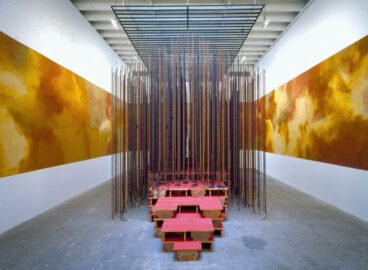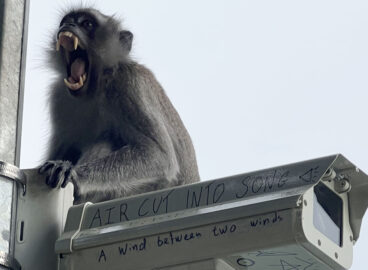This source is an English translation by Stephanie M. Hohlios of a compelling 1971 memoir-essay by Japanese artist Okamoto Tarō—“Watashi to jinruigaku: pari daigaku minzoku gakka no koro (Anthropology and I: My Time at the University of Paris Department of Ethnology)”.
Okamoto’s essay “Anthropology and I” sheds light on a widely recognized but little understood chapter in Okamoto’s life. He discusses his participation in the Abstraction-Création movement in Paris, and recalls his experiences at the Sorbonne and Musée de l’Homme, explaining his decision to study ethnology as pre-war hostilities intensified. The text describes his development of a theory of the “entire self”—an objective point of origin for identity that becomes clear in a collaborative environment—and how it bears on his theory of the object. In this shared space of creative-intellectual exploration, we learn, he sought to join other young “Others” in Paris in making a kind of alternative epistemology.
See the essay accompanying this translation here.
Watashi to jinruigaku: pari daigaku minzoku gakka no koro (Anthropology and I: My Time at the University of Paris Department of Ethnology)
By Okamoto Tarō 1971
Publisher Kikan jinruigaku 2, no. 1
Language Japanese
At the age of eighteen, I went to Paris. Precisely because I was in Paris, I had the freedom to express myself and was able to think that there is a splendid, promising future for the arts. At this time in Japan, a dark and bitter mode of expression had taken hold, and something that felt like a tune sung by a hoarse voice that only adults can hear came to be valued.
There was an attitude, one might say, that to leave Japan was preferable. But with regard to Paris, actually, it was first a sense of hopelessness and despair that I remember, and a sense that the future was uncertain. To merely paint a golden-haired woman or sketch a Paris street corner had a grotesqueness to it. It was this empty mode of “European sojourn art” (j. taiō sakuhin), in which painters who came from Japan to study abroad, immersed themselves. I couldn’t stand it. But after worrying and suffering, I finally joined a group of abstract artists in their tiny but intense movement. Here, the customs of the world’s peoples, and cause and effect, were frames to be exceeded through painterly expression rooted in the coincidence of global occurrence. As a foreigner in Paris, it meant emancipation.
But even so, I began to harbor deep skepticism about this concept. At that time, abstraction meant placing pure form on the canvas, which made aesthetics a problem. And the closer you examine such form, this visual realm evacuated of thought, the more it yields a sense of nihilism. What is “beauty” or “aesthetics” even? In this vast and turbid terrain of life, one is alone—floating, self-complacent, and intoxicated, one might say. I thought it merely petty—applying this kind of color, being obsessed with form. The more I did this, the more I thought it was necessary to think about the origin of my entire self, of my essential way of living and being. Whether it was unsightly or not, it was better to let creation press forth from the original source. In a magazine devoted to the abstraction movement around this time, I called out hopelessly for “a color that’s not color, for form that’s not form.”1This summer, coincidentally, a certain French critic sent this same document to me, which I had forgotten.
I wanted to grasp the meaning of existence. Because of this desire, I came to study philosophy and sociology at the Sorbonne. To the bitter end, I remember this cold, pressing philosophical thought, theory, etc., and Hegel’s dialectic, held great allure for me.
Once a week, just seven or eight of us would gather around a table in a little study with only one window to listen to lectures by Professor [Alexandre] Kojève of the [École Pratique des] Hautes Études. [Georges] Bataille, Raymond Aron, and [Pierre] Klossowski were always avid participants. At this time, I eagerly soaked in the goings-on of the College of Sociology and even parried during discussions with sharp, intellectual exchanges.
However, philosophical speculation alone was of course not enough. Somewhere shortly after the 1937 Paris Exposition, the Musée de l’Homme in the Trocadero opened. Its goal was to grasp at the raw actuality of existence. If we don’t first do this—grasp the truth of life—then grasping the meaning of art is not possible. So, I transitioned to the ethnology program, alongside Patrick Waldberg, and began working at the Musée de l’Homme.
From the world’s disparate regions, the Musée de l’Homme gathered ways of living that exceeded the imagination in all their diversity and weirdness (j. sugomi). Pictures and other artworks—as cultured valuations—were turned upside down to create a cosmic sense of existence. This existence, its vulgarity, transcended the empty affectation and display of today’s progressive society to directly confront one with its own repletion. It gives me chills to think back on it with such attention.
Art is a deductive rolling-out of an image from an isolated space. But ethnology is a total critique of subjective judgment that produces a refined conclusion. In the locus of the push and pull of these two mental bearings, one should discover a real and personal way of living.
Of course, even though I studied ethnology, I didn’t intend to pursue it as a “specialty,” nor did I really have a view to become a scholar. But I will say that the meaning of humanity’s, and indeed my own, existence, the root and reason for living—this is what I continued to chase.
I abandoned the paintbrush and dove full bore into this. Completely alone, I confronted my nihilism, and the more I continued onward, compared to that empty “art for art’s sake,” the more the academic world provided a steady basis for me. And little by little, over time, as I played my part with all my effort, I became part of a collaborative environment. I was very pleased.
The aged professor Marcel Mauss, the nephew of [Émile] Durkheim, was a person of great learning. Some thought him frightening but he was actually quite innocent and soft, and somehow childlike. But he was extremely passionate in his lectures and really pulled you in.
Anthropology professor Paul Rivet was rather cold, but his wife had a motherliness about her and did a lot for us students. At one point in the Anthropology Department, everyone deciphered their blood types by pricking their finger underneath their nail to draw blood, and then analyzing it. I tried to duck out and absent myself because I wasn’t too interested. But before long, Mademoiselle Rivet2 noticed and started looking for me among the students. When she came to my seat, I suddenly answered mischievously, “I’m type C.”3
Even now I get embarrassed thinking about this, but when she came over to enter my findings on her sheet, she suddenly stopped in surprise. She raised her eyes and calmly looked me in the face, understanding immediately. “Ah, you’re one of those who can’t do it,” she said with confidence. All the other students burst out laughing.
There was a rumor spreading at the time: “When Okamoto announced his blood type was C, Professor Rivet was completely surprised, and he ran home from the laboratory to consult the literature.”
Soon war broke out and students left one by one for the front. When the German Army invaded Paris, even I, who had stayed around while the others around me left, finally decided to return to Japan.4 In addition to what I have already stated above about the general frame of mind in these years, there’s not much more to say. Truly at odds with society [in France], I as a Japanese individual, knew it was best to return home to Japan.
I went to the Musée de l’Homme to say a final goodbye and was happy to see Professors Mauss and Rivet there together. The elderly Mauss said with an emotional grip on my hand, “Ah, is that right? I am sad to see you go. It’s really such a shame.” Professor Rivet was a little stiffer and more standoffish. As Germany conquered Paris, Japan was its ally, and so I was returning home to an enemy country . . . I could see this in his face. I felt as though I was being torn in two.
When I was back in Japan, I was truly alone. As a result, as a form of personal declaration, art was my closest ally, my fiercest weapon. All my pictorial work from this period is a sullen ash color. It is significant that this mood permeated the craftsman’s world in these years, impactfully inserting itself as a primary color. The understanding I had acquired in anthropology and sociology supported me body and mind in this period. Even now, these continue to labor within my heart, I think.


